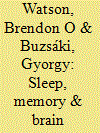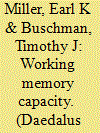| Srl | Item |
| 1 |
ID:
137675


|
|
|
|
|
| Summary/Abstract |
In this article we explore the complexities of what goes on in the brain when one wishes to perform even the simplest everyday movements. In doing so, we describe experiments indicating that the spinal cord interneurons are organized in functional modules and that each module activates a distinct set of muscles. Through these modules the central nervous system has found a simple solution to controlling the large number of muscle fibers active even during the execution of the simplest action. We also explore the many different neural signals that contribute to pattern formations, including afferent information from the limbs and information of motor memories.
|
|
|
|
|
|
|
|
|
|
|
|
|
|
|
|
| 2 |
ID:
137672


|
|
|
|
|
| Summary/Abstract |
Sleep occupies roughly one-third of our lives, yet the scientific community is still not entirely clear on its purpose or function. Existing data point most strongly to its role in memory and homeostasis: that sleep helps maintain basic brain functioning via a homeostatic mechanism that loosens connections between overworked synapses, and that sleep helps consolidate and re-form important memories. In this review, we will summarize these theories, but also focus on substantial new information regarding the relation of electrical brain rhythms to sleep. In particular, while REM sleep may contribute to the homeostatic weakening of overactive synapses, a prominent and transient oscillatory rhythm called “sharp-wave ripple” seems to allow for consolidation of behaviorally relevant memories across many structures of the brain. We propose that a theory of sleep involving the division of labor between two states of sleep–REM and non-REM, the latter of which has an abundance of ripple electrical activity–might allow for a fusion of the two main sleep theories. This theory then postulates that sleep performs a combination of consolidation and homeostasis that promotes optimal knowledge retention as well as optimal waking brain function.
|
|
|
|
|
|
|
|
|
|
|
|
|
|
|
|
| 3 |
ID:
137677


|
|
|
|
|
| Summary/Abstract |
Why can your brain store a lifetime of experiences but process only a few thoughts at once? In this article we discuss “cognitive capacity” (the number of items that can be held “in mind” simultaneously) and suggest that the limit is inherent to processing based on oscillatory brain rhythms, or “brain waves,” which may regulate neural communication. Neurons that “hum” together temporarily “wire” together, allowing the brain to form and re-form networks on the fly, which may explain a hallmark of intelligence and cognition: mental flexibility. But this comes at a cost; only a small number of thoughts can fit into each wave. This explains why you should never talk on a mobile phone when driving.
|
|
|
|
|
|
|
|
|
|
|
|
|
|
|
|